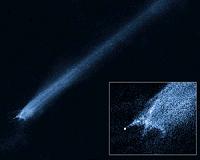 |
Washington DC (SPX) Dec 17, 2010 Scientists from all over the world are taking a second, more expansive, look at the car-sized asteroid that exploded over Sudan's Nubian Desert in 2008. Initial research was focused on classifying the meteorite fragments that were collected two to five months after they were strewn across the desert and tracked by NASA's Near Earth Object astronomical network. Now in a series of 20 papers for a special double issue of the journal Meteoritics and Planetary Science researchers have expanded their work to demonstrate the diversity of these fragments, with major implications for the meteorite's origin. In the first round of research, Carnegie Geophysical scientist Doug Rumble, in collaboration with Muawia Shaddad of the University of Khartoum, examined one fragment of the asteroid, called 2008 TC3, and determined that it fell into a very rare category of meteorite called ureilites. Ureilites have a very different composition from most other meteorites. It has been suggested that all members of this meteoric family might have originated from the same source, called the ureilite parent body, which could have been a proto-planet. Now Rumble has expanded his work to examine 11 meteorite fragments, focusing on the presence of oxygen isotopes. Isotopes are atoms of the same element that have extra neutrons in their nuclei. Rumble explains: "Oxygen isotopes can be used to identify the meteorite's parent body and determine whether all the fragments indeed came from the same source. Each parent body of meteorites in the Solar System, including the Moon, Mars, and the large asteroid Vesta, has a distinctive signature of oxygen isotopes that can be recognized even when other factors, such as chemical composition and type of rock, are different." Rumble and his team prepped tiny crumbs of these 11 meteorite fragments and loaded them into a reaction chamber where they were heated with a laser and underwent chemical reactions to release oxygen and then used another device, called a mass spectrometer, to measure the concentrations of these oxygen isotopes. Results showed that the full range of oxygen isotopes known to be present in ureilites were also present in the studied fragments. "It was already known that the fragments in the Nubian Desert came from the same asteroid. Taking that into account, these new results demonstrate that the asteroid's source, the ureilite parent body, also had a diversity of oxygen isotopes," says Rumble. The diversity of oxygen isotopes found in ureilites probably arises from the circumstances of the parent this body's formation. Rumble theorizes that the rock components of this parent body were heated to the point of melting and then cooled into crystals so quickly that the oxygen isotopes present could not come to an equilibrium distribution throughout. Together the collection of 20 papers published in Meteoritics and Planetary Science offer enormous insight about the formation and composition of ureilites and their hypothesized parent body.
Share This Article With Planet Earth
Related Links Carnegie Institution Asteroid and Comet Impact Danger To Earth - News and Science
 Building Blocks of Life Created In "Impossible" Place
Building Blocks of Life Created In "Impossible" PlaceGreenbelt MD (SPX) Dec 16, 2010 NASA-funded scientists have discovered amino acids, a fundamental building block of life, in a meteorite where none were expected. "This meteorite formed when two asteroids collided," said Dr. Daniel Glavin of NASA's Goddard Space Flight Center, Greenbelt, Md. "The shock of the collision heated it to more than 2,000 degrees Fahrenheit, hot enough that all complex organic molecules li ... read more |
|
| The content herein, unless otherwise known to be public domain, are Copyright 1995-2010 - SpaceDaily. AFP and UPI Wire Stories are copyright Agence France-Presse and United Press International. ESA Portal Reports are copyright European Space Agency. All NASA sourced material is public domain. Additional copyrights may apply in whole or part to other bona fide parties. Advertising does not imply endorsement,agreement or approval of any opinions, statements or information provided by SpaceDaily on any Web page published or hosted by SpaceDaily. Privacy Statement |